Wildlife Sightings North And East Yorkshire - November 2018
November started even better than October ended with some great scarce and rare birds on the coast. A South-south easterly airstream on the 1st brought a whole load of great sightings to Spurn. Pallas’s Warbler, Great Grey Shrike, Richards Pipit, Waxwing and Firecrest graced the Observatory area. A Hoopoe was an unseasonal and surprise find at Escrick also on the 1st.
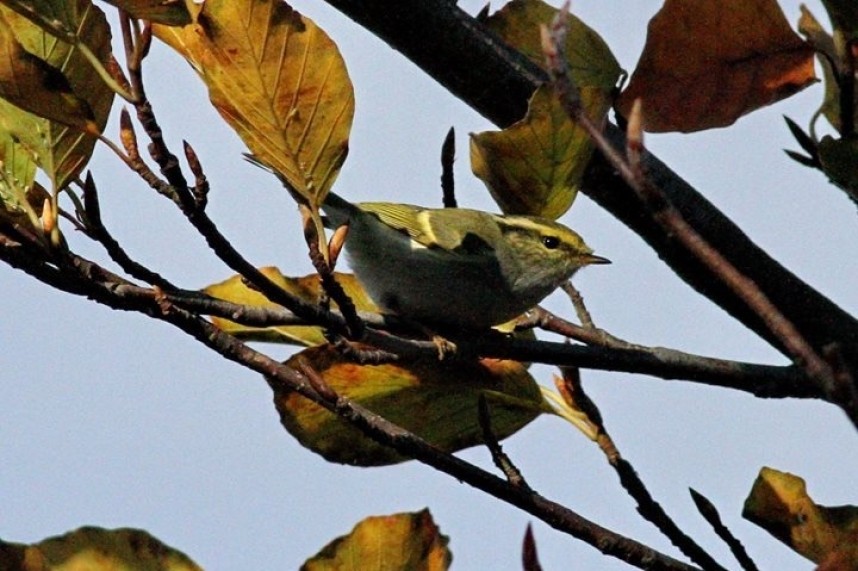
Pallas's Warbler at Spurn © Richard Willison
Flamborough had to wait until the 2nd to increase birders blood pressure. A White-tailed Eagle flew north over Spurn in the morning, then over Holmpton and kept going. Amazingly it continued to fly north and arrived over South Landing Flamborough at 1550 to the delight of locals. South Landing was then the place to be that afternoon with Little Bunting caught by the ringers and nearby Yellow-browed Warbler, Siberian Chiffchaff and a probable Siberian blythi Lesser Whitethroat. Further north at Filey a Rough-legged Buzzard was seen on the 2nd with possibly the same bird at Long Nab earlier in the day where there were also two Little Auks seen. Western Cattle Egrets are still a rare bird in Yorkshire so a sighting of one flying past Nosterfield on the 2nd was a good record. Another Rough-legged Buzzard was seen at Lockwood Beck on the 4th. A Firecrest was seen a few miles inland in a garden in Hutton Buscel on the 4th.
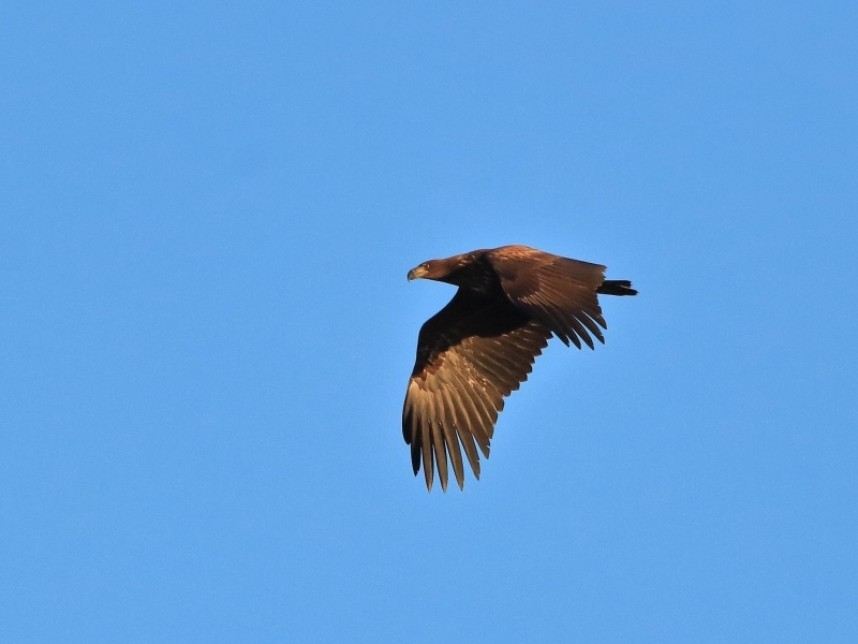
White-tailed Eagle Kildale © Reece Fowler
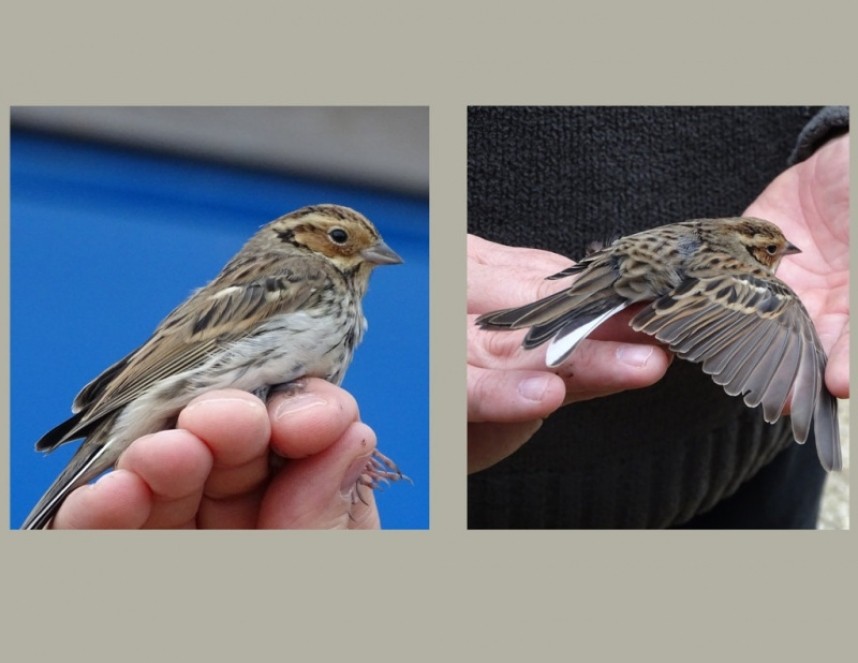
Little Bunting at Flamborough © June and Malcom Fox
The rarest bird prize of the month though goes to Tony Broom at Easington on the 4th who found a Dusky Thrush in the Vicars garden, the same garden the Siberian Accentor was found in 2016! Nearby only the 7th ever Spurn record of Red-crested Pochard with one seen flying over the Humber. On the 5th Spurn finally got their own Rough-legged Buzzard, nearby a Glaucous Gull, three Water Pipit, seven Snow Bunting and six Shorelark on the same date. After everyone thought the White-tailed Eagle had vanished into thin air, it appeared again at Kildale in the North York Moors National Park on the 6th. A probable Pallid Swift was seen over Northallerton town on the 7th with another two birds seen over South Gare on the same date. Flamborough scored again with a Rough-legged Buzzard on the 8th. Another lone Firecrest was at Filey on the 9th. Birders looking for the Eagle in Sleddale NYMNP were then rewarded with a Rough-legged Buzzard there on the 9th and a Shorelark nearby, what a difference more eyes make! The coastal Observatories were back on track the same day with a Hume’s Warbler at Flamborough, the first sighting of this species in our area this autumn...
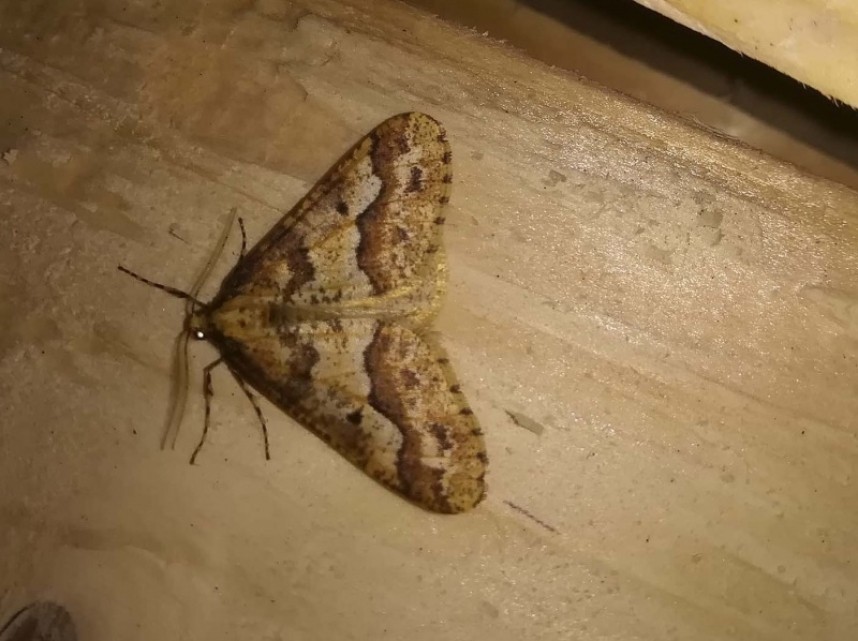
Mottled Umber Broxa Forest © Allan Rodda and Jackie Holder
Moth records were typically few and far between in the chilly weather. However, there were still some great species to be found. 15 December Moths were caught in the Esk Valley on the 4th. The Scarborough moth team caught their first Mottled Umber of the winter at Broxa on the 5th. A Dark Sword-grass and a Beaded Chestnut were caught in Kilnsea on the 5th and a Hummingbird Hawkmoth was a great find in a York garden on the 8th.
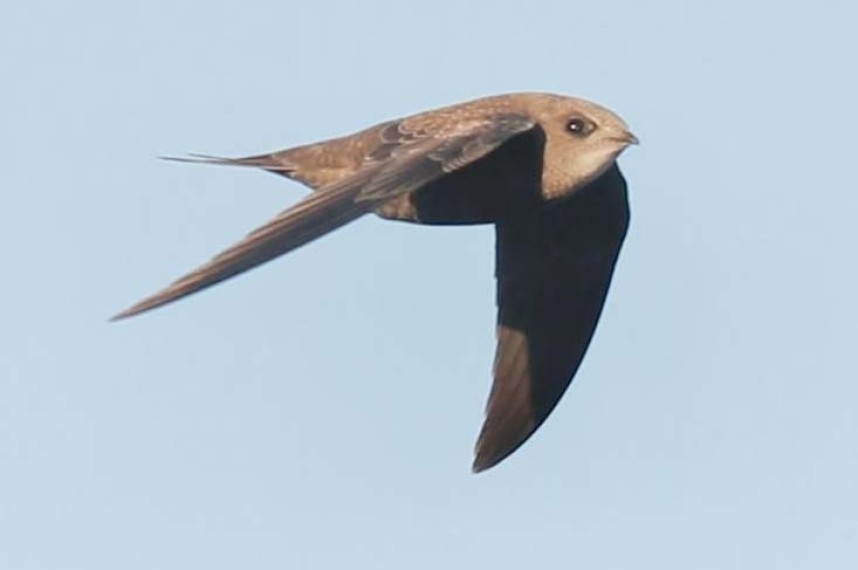
Pallid Swift at Flamborough © Trev Charlton
This raptor rush in the National Park was enhanced further with several reports of Hen Harriers including an adult male in the Farndale area. Down on the Humber small numbers of Hen Harriers were being seen hopefully now sticking around for the winter… Several sightings of Hen Harriers were also reported from the northern coastline including one hunting at Buckton with a Short-eared Owl and a Barn Owl. The most significant sighting on the 10th was the discovery of three Hawfinch back at the Yorkshire Arboretum, increasing to 10 on the 11th. After the fantastic winter for these birds in 2017/18 it was wonderful to hear of a small number returning. A Richards Pipit flew over the vis-mig crew at Hunmanby Gap on the 11th. Swifts were back on the agenda on the same date when a Pallid Swift was found at Kilnsea, this was followed by one later in the day at Flamborough flying around the new Sea-watching hide, a great christening! A possible Pallid Swift was seen at Long Nab on the same day. It or another was confirmed as that species a day later when a Pallid Swift spent a valuable few minutes over the cliffs of the Nab. Filey also got in on the Pallid Swift show on the 13th when one graced the Brigg. Three Shore Lark flew over Bempton on the 12th.
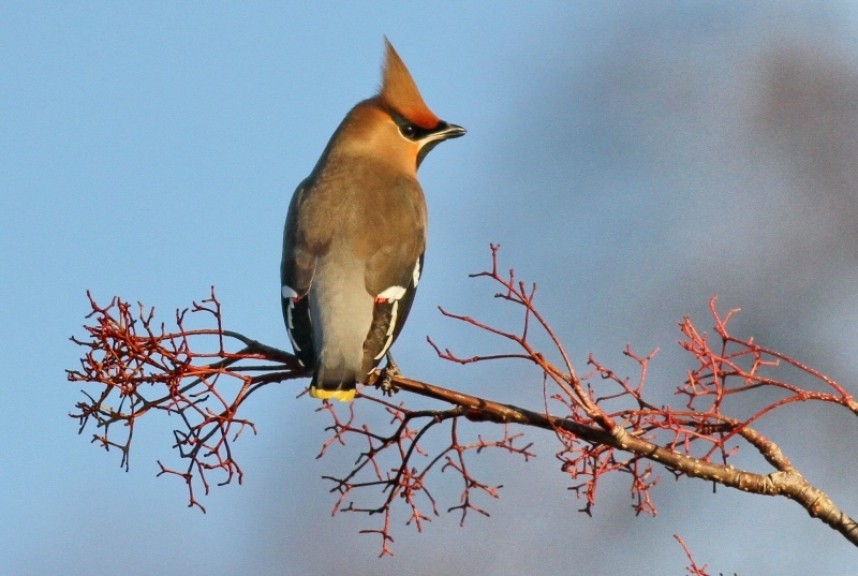
Bohemian Waxwing in Hessle © Richard Willison
Five Tundra Bean Geese arrived in-off the sea at Long Nab on the 13th and on the 15th 10 Bohemian Waxwings were found in Scarborough. The first two weeks of the month had been the best period of the whole autumn for the Filey and Scarborough Birders. Further inland during this period, a Bearded Tit was a great local bird at Scorton and a red-head Smew arrived at Nosterfield both on the 11th. The westward inland movement of small warblers arriving on the coast was highlighted with a Siberian Chiffchaff at Blacktoft Sands RSPB on the 13th, with three Water Pipits were also seen on the same day. The 13th was also a great day on the coast for Pink-footed Geese with significant movements recorded; 1119 were seen over Flamborough where 42 Whooper Swans also moved south and 599 Pink-feet over Spurn. Down at Spurn on the same date, a significant movement of Wood Pigeon was underway with 3,504 counted along with 242 Stock Dove! A very unseasonal European Turtle Dove was found in Easington on the 14th. Little Gulls were present almost daily close inshore off Flamborough Headland throughout the first part of the month with 100 still there on the 14th and an impressive 747 counted on the 17th. On the same date Flamborough experienced some good new arrivals including a Richard Pipit and a Hawfinch and a good sea passage which included 180 Common Eider, Pomarine Skua, Sooty Shearwater and Black-throated Diver. A small arrival of Common Redpoll was also recorded at Flamborough and Filey on 17th/18th with 12 ringed at Flamborough on the 23rd. A Dusky Warbler in an Easington garden was a good find on the 17th especially as they have been very scarce this autumn on the east coast. At South Gare the Twite flock was still present with 70 counted. Our second biggest flock in the region was counted down at Sunk Island mid-month when 35 were seen.
Cetaceans were suddenly back in the news mid-month when a Risso’s Dolphin was seen on the River Ouse near Skelton but not again after the first sighting.
Lock park Redcar was the place to be on the 18th when an adult Black-crowned Night Heron was found. Hornsea was back in the bird news on the same day when four Tundra Bean Geese flew south with a further 18 recorded over Spurn the same day. Even better were two Leaches’ Petrel seen offshore at Hornsea two days later with an impressive list of Black-necked Grebe (increasing to three birds on the 22nd), Smew, Great Egret and three Greater Scaup on the Mere on the same day. A very late Northern Wheatear was found at Flamborough on the 18th with another at Skinningrove on the 20th. A Taiga Bean Goose was at Easington with Pink-footed Geese from the 20th. The Black-crowned Night Heron was found again on the 21st. Nearby the Twite flock were up to 100 at South Gare with a Slavonian Grebe offshore. The excellent autumn for Long-eared Owls continued down at Spurn with two trapped there in the Heligoland Trap on the 21st. A very unseasonal Willow Warbler was trapped and ringed at Flamborough on the 22nd. A Eurasian Bittern was seen at Filey on the 23rd with the regular Red-necked Grebe still showing off the Brigg. Another Eurasian Bittern was seen at Flamborough on the 29th. These Bittern wintering records have become annual in recent years, a big change from their previous status as a very rare bird on the coast. Friday the 23rd was a good day at Spurn with four Bewick’s Swan seen, a Richard Pipit, the Taiga Bean Goose and most unusually a Long-tailed Skua. A day later both Great Skua and Pomarine Skua were also seen. This was followed up in style on the 25th when a Hume’s Warbler was found at Kilnsea with another heard in the Scarborough area on the 26th. Filey bay is the best place to connect with Black Guillemot on our coastline with almost annual sightings and sure enough one was found there on the 25th. A Rose-coloured Starling was seen in a private garden in Hull on the 26th.
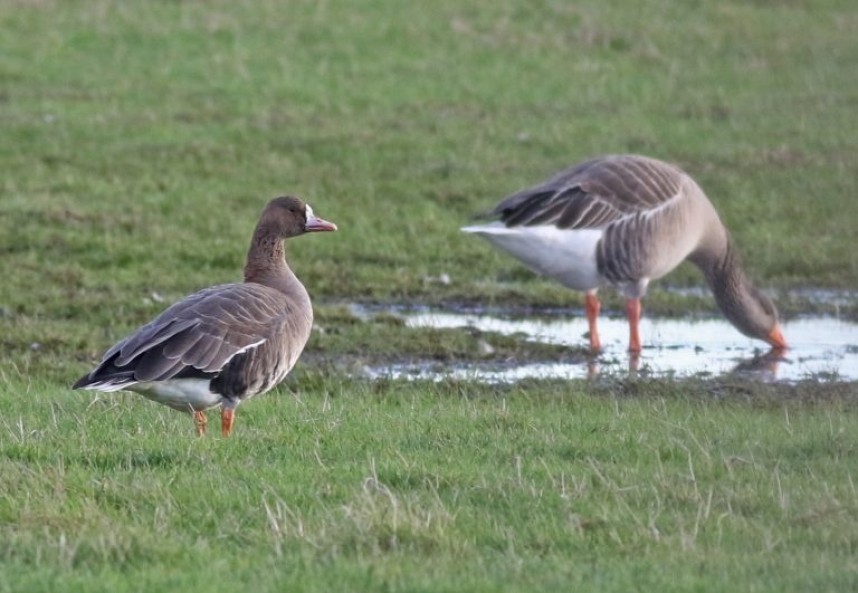
Bohemian Waxwings are always popular but this winter they have been tricky to nail down for more than a day so nine at Hessle for several days from the 28th were greatly appreciated by local birders and photographers. A further eight in the Scarborough area on the 30th were typically brief. With so few Snow Buntings regularly wintering on our coastline these days, eight feeding on Filey Brigg on the 28th, eight flying over Flamborough and seven birds feeding together at Redcar were significant in the final part of the month. The final day of the month saw the start of an influx of waterfowl, Eurasian White-fronted Geese headlined the show with 15 arriving at Flamborough along with a Tundra Bean Goose and four Bewick’s Swan, the rarest of the three at Flamborough. On the same day Thornwick Pool held a good count of 17 Common Snipe and one Jack Snipe. In the Scarborough/Wykeham Lakes area the almost resident one or two Great Egrets were still present at the month end. In the final part of the month there were still a few moths around. A Dark Sword-grass was at Flamborough on the 26th and on the 30th seven species were found in the polytunnel nursery at Nosterfield Nature Reserve including 14 Scarce Umber, a new species for the reserve!
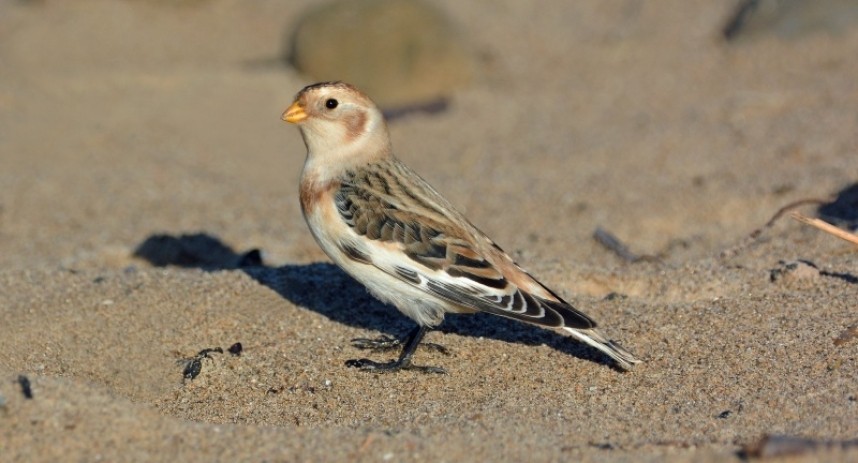
Snow Bunting at Redcar © Damian Money
Many thanks to all the observers who contributed sightings and photographs. This article covers North and East Yorkshire. For more wildlife sightings visit these great local, regional and national web sites
Spurn Bird Observatory, Flamborough Bird Observatory, Filey Bird Observatory and Group, Northern Rustic blogspot , Yorkshire Naturalists Union, Yorkshire Wildlife Trust, Scarborough Birders, Butterfly Conservation Yorkshire Branch Yorkshire Nature Traingle For National News: Birdguides
Richard Baines
Yorkshire Coast Nature



 Back to Blog
Back to Blog
